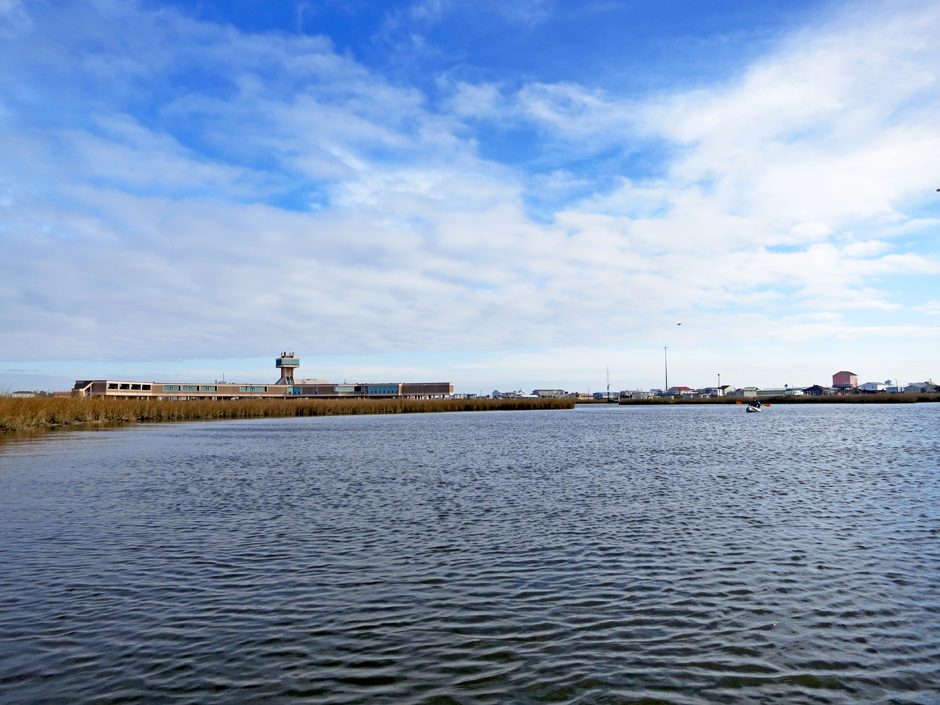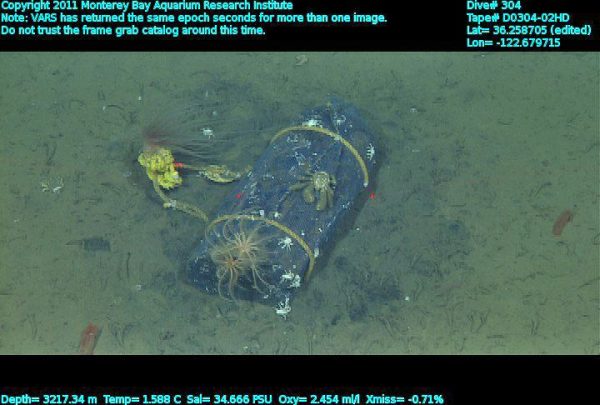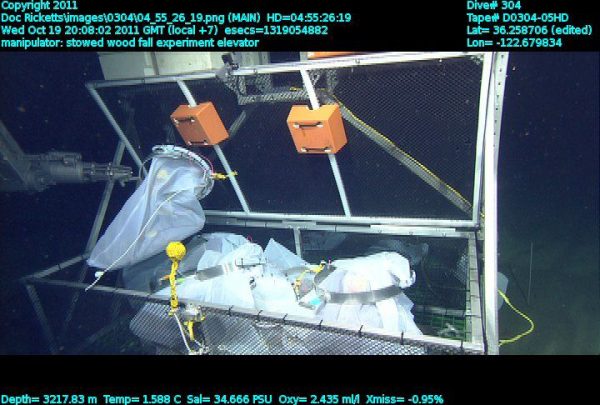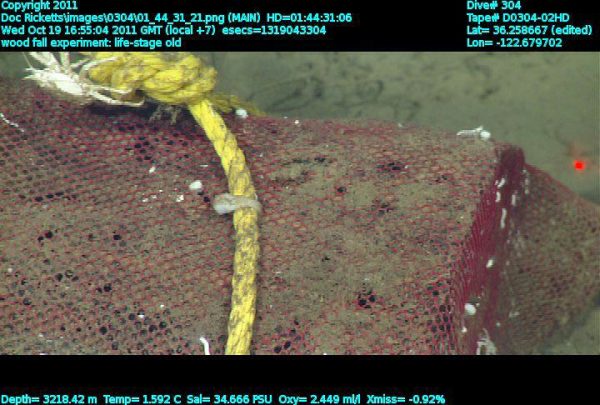Little Worlds of Wood on the Ocean Floor
 Louisiana Universities Marine Consortium (LUMCON), Jan 2013. (Credit: Shannon Dosemagen [CC BY-SA 2.0 (https://creativecommons.org/licenses/by-sa/2.0)])
Louisiana Universities Marine Consortium (LUMCON), Jan 2013. (Credit: Shannon Dosemagen [CC BY-SA 2.0 (https://creativecommons.org/licenses/by-sa/2.0)])As Earth’s climate warms, so do its oceans. The ability of the world’s oceans—and the many species that live in them—to adapt to warmer conditions remains a mystery. Researchers are now exploring how benthic macroinvertebrates decompose wood falls, fallen timber deposits, at the bottom of the ocean to determine how much access to food influences biodiversity.
Dr. Craig McClain, Executive Director of the Louisiana Universities Marine Consortium (LUMCON), spoke to EM about the research.
“The work started years ago in 2008, and at the time I was at the Monterey Bay Aquarium Research Institute (MBARI) out in California,” explains Dr. McClain. “My post-doctoral advisor, Jim Barry, was doing deep sea work and asked me if I’d like to tack anything onto that. I proposed that we put out some experimental wood falls in the benthic elevator, and he was keen to collaborate with me on that because rule number one is don’t send a benthic elevator down to the sea floor half full. When you’re doing deep sea work, it’s so expensive and there’s so much strain with time and logistics that you must capitalize on any opportunity. And so, in this case, it was only half full, so we determined what else can we take down to the seafloor, and that’s how this wood fall experiment started.”
Wood falls, pieces of wood fallen onto the seafloor to decay, are both food and home to a range of invertebrate species—many of which can’t be located anywhere else in the sea. Because their food source is either the wood itself or the invertebrates that eat wood, these species are tethered to the wood falls for life, from larvae to grave.

View from a wood fall. (Credit: MBARI, http://www.deepseanews.com/2018/09/wooden-homes/)
“We studied wood falls for a couple of different reasons,” clarifies Dr. McClain. “We know very little about these communities on the seafloor. What kind of species we find there, how these habitats feed into the global biodiversity of the ocean and the deep sea, but they are also really fantastic experimental systems. That’s the main reason my lab works on them still, to this day, because we want to know how individual animals, how species themselves, and how whole communities of organisms respond to varying levels of food availability.”
Rapid changes, unpredictable outcomes
Human-driven climate change is transforming the world’s oceans—and threatening their ability to provide food to the species that depend on them.
“With climate change, in the oceans we are getting changes to the carbon cycle and to overall carbon availability in the ocean,” details Dr. McClain. “We are restructuring food webs; we are changing and altering the patterns of body size of organisms. A whole variety of things are happening, but we don’t know a lot because it’s very hard to go experimentally test how these systems are going to respond. We can’t go out to a spot in the ocean and increase or decrease the amount of food available to it.”
Researchers aren’t sure how ocean life, both individual species, and entire communities, will respond to these complex changes, and adjusting how much food species a marine ecosystem receives isn’t typically possible—except in a wood-fall experiment.
“These wood falls form little test systems in which we can control the food that community gets simply by changing the size of the log, because the whole group of invertebrates that lives on the wood is completely nutritionally dependent on that wood as a source of food, or, alternatively, prey upon species that eat the wood,” Dr. McClain describes. “So we can adjust these little food islands and how much food they get simply by changing the island’s size. They allow us to test when you provide a community with more food, where does that energy go. Is it more complex food webs, or is more kind of different types of animals. Like different types of strategies and niches. Are things bigger or is there more of everything?”
Creating little worlds
The wood fall experiments began in 2006 when the team used an ROV to place 16 logs on the deep seafloor.
“I needed a source of wood and at the time my wife was working at a land trust,” states Dr. McClain. “They had just cut down some old acacia trees on the property so I picked up all this old acacia and used that for the original wood fall. Acacia is all up and down the California coast, and it was freely available.”
After five years, they harvested the wood falls remotely and robotically. Sorting, identification, and analysis showed that oceans that are less productive will mean less biodiversity because species sharing wood falls compete for food and space.

Wood fall experiment elevator. (Credit: MBARI, http://www.deepseanews.com/2018/09/wooden-homes/)
Although the first round of experiments are over, the wood fall project continues.
“Those all have been collected, but then last year we put out two hundred wood falls across the Gulf of Mexico as part of a National Science Foundation grant,” Dr. McClain mentions. “We will go out in February and April to collect the two hundred. Depending on how you define things, it may be one of the largest deep-sea experiments ever done. ”
However, as is often the case, the initial round of wood fall experiments prompted many additional queries.
“Just as the first set of experiments was more limited in number and left all kinds of questions for me that sparked the newest round of experiments, this new set will open up the door to a whole set of new questions,” remarks Dr. McClain. “So, for example, Acacia is a very hard wood, so it takes a while for things to bore into the wood. So the rate at which that wood, that food, is made available to the community is slow.”
In other words, a softer wood and a faster decomposer might mean a totally different process.
“If we use a softer wood like pine then the patterns may look a lot different because food becomes available to the entire community of organisms quicker,” adds Dr. McClain. “It’s going to take a while to work up 200 wood falls, but we are really excited as a group.”
At four of the team’s sites, they have “replicated treatment,” meaning that four sites are completely identical to one another. At each of these identical sites, there are 12 pieces of pine and 12 pieces of hackberry ranging in size from around 1 to 22 kilograms.
“We have one additional site where we laid out 100 total wood falls that vary by both size and wood types,” comments Dr. McClain. “There are 11 different species of trees: three different types of oak, pecan, magnolia, elm, willow, sugarberry, cypress, two different types of pine, so we don’t yet know if the types of wood, in terms of the natural history of wood falls, have different types of invertebrates living on them.”

Bore holes are visible in wood fall. (Credit: MBARI, http://www.deepseanews.com/2018/09/wooden-homes/)
Like any such monitoring experiment, the team is deducing what’s happening when they aren’t watching.
“We’ve replicated that same experiment at four different sites, and you know, if we get differences at one site we may not know why that site is different,” remarks Dr. McClain. “It may have been something random that might not have happened at the other sites. So its a little bit like being a forensic scientist, you only get the aftermath and you have to piece together what happened to get to that point.”
Technological advances help but do not solve the problem.
“We can leave long-term cameras on there, but they are limited by the battery power and things like that,” states Dr. McClain. “So, we just get snapshots in time. I often collaborate with a paleobiologist because our thinking and strategies happen to be the same. I have limited samples, because of the remoteness and difficulty of doing research in the deep ocean. It’s the same with the paleobiologist, they have limited samples sizes, what the fossil record gives them, and that may not be a lot. We do the best we can.”
In fact, this experimental design is revealing many details we didn’t know before—but that’s no surprise to Dr. McClain.
“I think in the deep sea sciences there’s always a lot of aha moments,” muses Dr. McClain. “Every time I do work in the deep sea there are new species that are unknown to science and probably unknown to humans in general. We are always discovering something new, that’s part of the intrigue in doing work in the deep sea. You’re one part explorer and one part scientist.”
“I mean we are creating little worlds on the ocean floor.”




0 comments